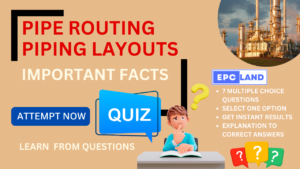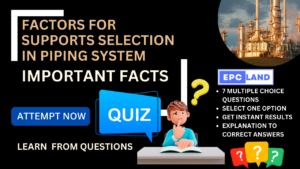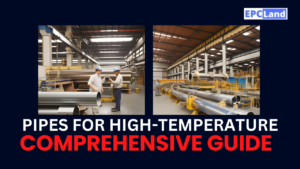1. Environmental Impacts: Principles of Pipeline Design
What are the three main areas of environmental impacts associated with pipelines as per Principles of Pipeline Design?
Explanation: The three main areas of environmental impacts associated with pipelines are habitat loss and fragmentation, water pollution, and air pollution.
2. Routing Considerations
What factors should be considered when routing a pipeline to minimize its environmental impact?
Explanation: When routing a pipeline, factors to consider for minimizing environmental impact include sensitive habitats, water resources, and topography.
3. Indirect Environmental Impacts
What is mentioned as an example of an indirect environmental impact associated with pipelines?
Explanation: An example of an indirect environmental impact associated with pipelines is increased greenhouse gas emissions from fossil fuel transportation.
4. Legal Considerations
What legal requirements are typically imposed on pipeline operators?
Explanation: Pipeline operators must comply with property rights laws, zoning regulations, safety regulations, and other legal requirements.
5. Environmental Laws
What is the role of environmental laws in the construction and operation of pipelines?
Explanation: Environmental laws mandate pipeline operators to obtain permits, conduct environmental assessments, and implement mitigation measures.
6. Routing and Water Resources
Why should pipelines be routed away from water sources?
Explanation: Pipelines should be routed away from water sources to minimize the risk of spills and leaks, thereby protecting water quality and aquatic life.
7. Topography and Pipeline Routing
How does topography influence pipeline routing?
Explanation: Topography influences pipeline routing by affecting the need for grading and excavation, which can influence land disturbance.
Principles of Pipeline Design
Pipelines are a critical component of modern infrastructure, transporting essential resources such as oil, natural gas, and water over long distances. However, pipeline construction and operation can have significant environmental impacts.
1.1 Effect on the environment
The environmental impacts of pipelines can be broadly categorized into three main areas:
- Habitat loss and fragmentation: Pipelines often require clearing of vegetation and disruption of natural habitats, which can harm wildlife populations and ecosystems.
- Water pollution: Pipeline leaks and spills can contaminate water sources, both surface and groundwater. This can have serious consequences for drinking water supplies and aquatic life.
- Air pollution: Construction and operation of pipelines can generate air pollutants, such as dust, fumes, and emissions from vehicles and machinery. These pollutants can contribute to respiratory problems and other health issues.
In addition to these direct impacts, pipelines can also have indirect environmental impacts, such as increased greenhouse gas emissions from the transportation of fossil fuels.
1.2 Routing
The routing of a pipeline is one of the most important factors in minimizing its environmental impact. Careful consideration should be given to the following factors when routing a pipeline:
- Sensitive habitats: Pipelines should avoid sensitive habitats, such as wetlands, forests, and areas of high biodiversity.
- Water resources: Pipelines should be routed away from water sources, such as rivers, streams, and lakes, to minimize the risk of spills and leaks.
- Topography: Pipelines should be routed along routes that minimize the need for grading and excavation, which can disturb the land and increase erosion.
1.3 Approval and legal considerations
The construction and operation of pipelines is subject to a number of environmental laws and regulations. These laws and regulations vary depending on the jurisdiction, but they typically require pipeline operators to obtain permits, conduct environmental assessments, and implement mitigation measures to minimize environmental impacts.
In addition to environmental laws, pipeline operators must also comply with a number of other legal requirements, such as property rights laws, zoning regulations, and safety regulations.
Table of Contents
Don’t miss the Course on Effective Isometrics Management: Check Now
Enrollment Link
Recommended courses (Published on EPCLand)
- Complete Course on Piping Engineering
- Basics of Piping Engineering
- Piping Layout Engineering
- Piping Material Engineering
- Piping Stress Analysis
- Material Requisitions
- Piping Material Specifications
- Valve Material Specifications
- Plant Design & Layouts-OISD 118
- Isometric Management
Library of Technical Articles
Don’t miss out the collection of 15+ articles on following topics:
- Basics of Oil and Gas Industry
- Valves
- Testing
- Tank
- Piping Bulk Items
- Pipe
- Metallurgy
- Piping Materials
- Layout
- Instrumentation
- Heat Exchanger
- Type of Contracts
- Codes and Standards
- ASTM Standards
- Articles on Piping Specialty Items
Video details of Complete Course on Piping Engineering
Why Enroll in the EPCLand
Proven Track Record– PTR
Activities & Achievements before launching EPCLand
- Published more than 50+ short courses
- 3000+ Enrolments
- More than 3,500,00 Minutes of watch hours in the last 2 years
- 4000+ Students in 100+ Countries
- Rating of 4+ out of 5
- 1000+ YouTube Videos
- 8K+ Subscribers
What Students will Learn
- Codes & Standards of the Energy Sector
- Piping Material Engineering
- Piping Layout Engineering
- Stress Analysis
Interesting facts
- All the published courses have been developed by Industry Experts with more than 2 decades of experience
- Content is based on Practical experience and real-time problems.
- Content is designed and organized in such a manner that it can be easily grabbed.
- Complete website, Blogs and Quiz sections are Planned, Designed and published by myself (About me: Atul Singla)
- Complete flexibility of Time & Location, Students can access the content from anywhere & anytime
- Moreover, once enrolled, the content can be access as many times as you want, which helps in understand the fundamentals in a better way.
Conclusion
In conclusion, our courses are meticulously crafted by industry experts with over two decades of hands-on experience. The content is rooted in practical knowledge, addressing real-time problems. The material is thoughtfully designed and organized for easy comprehension. Every aspect, from the website to blogs and quizzes, has been planned, designed, and executed by Atul Singla, ensuring a comprehensive and seamless learning experience. With the flexibility of accessing the content at any time and from any location, students have the freedom to learn on their terms. Furthermore, enrollment grants unlimited access, allowing learners to revisit the material as often as needed, fostering a deep understanding of the fundamentals.



